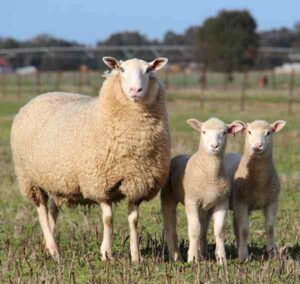The Border Leicester sheep is a dual-purpose breed of domestic sheep originated from United Kingdom. It has a long and dignified history, and was developed in 1767 in Northumberland, England.
Name of the breed came from the fact that their birthplace is near the border of Scotland with their foundation stock being Dishley Leicester rams.
Robert Bakewell created the Dishley Leicester sheep by crossing the old Lincolnshire breed with the Leicestershire type sheep. And the Dishley Leicester sheep breed became very popular with the local farmers.
Some Robert Bakewell’s Dishley Leicesters were bought by George and Mathew Culley, and the breed was soon found on both sides of the border. 2 distinct types of Dishley Leicesters were developing on the two sides of the border around the 1830s.
Some farmers in different areas along the border were crossing their sheep with Cheviots, while the Culley brothers were crossing their sheep with Teeswater sheep.
And this variation in the breed resulted in the two being nicknamed as the ‘Bluecaps‘ and the ‘Redlegs‘. The hardier redlegs were preferred by many farmers.
And the redlegs variety of the Dishley Leicester sheep became known as the Border Leicester sheep.
The Border Leicester sheep was a fairly common breed in the United Kingdom by the nineteenth century.
And the breed has been exported to some other countries such as India, Japan, Canada, Colombia, China, British Guiana, Spain, Iran, South Africa, France, Hungary, Portugal, Russia, Yugoslavia, Switzerland and Turkey.
Today the breed is raised for both meat and wool production. Read some more information about this breed below.
Border Leicester Sheep Characteristics
The Border Leicester sheep are large sized animals. Their body is long and are completely white in coloration. They have well sprung ribs and a wide, strong back.
They have a distinct roman nose which is much like the North Country Cheviot. And their nose is black and the ears are large in size, upright and alert. Feet of these animals are also of dark color.

Legs and head of these animals are generally free of wool and only covered in short white hairs (making it easier for shearing). Both rams and ewes are generally polled.
Average live body weight of the mature Border Leicester ewes is between 90 and 120 kg. And the mature ram’s average live body weight vary from 140 to 175 kg. Photo and info from Wikipedia.
Uses
The Border Leicester sheep is raised mainly as a meat sheep breed. But it is good for both meat and wool production.
Special Notes
The Border Leicester sheep are large in size and are robust animals. They are well known for their docility and good maternal qualities.
The ewes are excellent mothers and their average lambing percentages vary between 165 and 180 percent. The ewes produce enough milk for their lambs.
Along with being hardy, these animals are also very easy to keep and manage. It is good for both meat and wool production.
Wool of the Border Leicester sheep tends to be very long, broad crimped and in fineness about 32 to 38 microns.
The wool is used for medium to heavy weight garments, and is prized by spinners because of the crimp and luster.
The animals are generally shorn twice a year when the wool has reached a length of around 3.9 inches. The lambs on average produce around 1.8 of wool when shorn.
The yearlings have a larger body and they can produce as much as 3.2 kg of wool at each shearing.
Along with wool production, the Border Leicester sheep breed is also very good for quality meat production.
The ewes produce quality lambs, and the lambs have very high growth rate and finish quickly. They produce very high quality and desirable meat. The breed is also used for crossbreeding for improving other sheep breeds.
However, review full breed profile of the Border Leicester sheep in the following chart.
| Breed Name | Border Leicester |
| Other Names | None |
| Breed Purpose | Dual-purpose (meat, wool) |
| Special Notes | Large animals, very hardy and strong, robust, well known for their docility and good maternal qualities, ewes are excellent mothers, average lambing percentage is between 165 and 180 percent, the ewes produce enough milk for their lambs, although very large in size but they are very easy to keep and manage, good for both meat and wool production, wool is long and broad crimped, meat is of very good quality, lambs grow relatively faster |
| Breed Size | Large |
| Weight | Mature ram’s average live body weight is between 140 and 175 kg, and the mature ewe’s average live body weight vary from 90 to 120 kg. |
| Horns | No |
| Climate Tolerance | Almost all climates |
| Color | White |
| Rarity | Common |
| Country/Place of Origin | United Kingdom |






